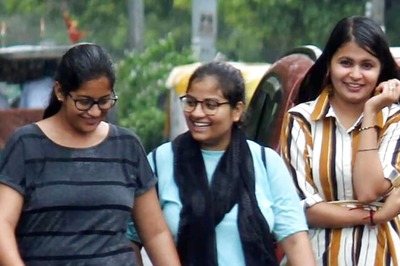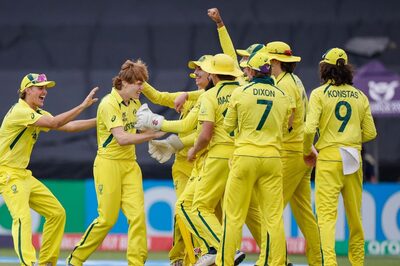
views
Delhi, the national capital, has experienced a summer unlike any other. The city sweltered through a prolonged period of record high temperatures, driven by a brutal heatwave fuelled by global warming. This relentless heat brought Delhi to its knees. Recent reports indicate that the sweltering heatwave has already led to nearly two dozen deaths in the capital this summer. The situation is likely to worsen, with the World Meteorological Organisation reporting that “Asia is heating up faster than the global average, with increased casualties and economic losses from floods, storms, and more severe heatwaves”.
Amid a sweltering heatwave, Delhi is also in the unprecedented grip of chaos, confusion, and extraordinary hardship, perpetrated on the common person due to the forceful return of the city’s familiar foe: never-ending water woes. What began as a crisis in informal slum settlements has since spread its tentacles to Lutyens’ Delhi, the President’s Estate, Parliament, the Prime Minister’s house, numerous posh colonies and markets. The Delhi Jal Board (DJB) is struggling to even supply potable water to major hospitals like AIIMS, Safdarjung, RML, and Lady Hardinge.
This article traces the origin of Delhi’s water woes, dissecting why it has assumed monstrous proportions before examining sustainable ways to alleviate the fast-worsening situation. But before I proceed further, it is time to take note of the recent observations made by a vacation bench of Justices P.K. Mishra and P.B. Varale of the Supreme Court of India.
Their Lordships identified the tanker mafia and water spillage as the primary culprits behind Delhi’s chronic water shortage. The Court issued a stern warning to the Aam Aadmi Party (AAP) government, urging them to rein in the mafia. Should the government fail, the Supreme Court cautioned that it would unleash the Union government-controlled Delhi police on the water mafia and those responsible for water wastage.
It is as bad as it can get.
Causes, consequences, and remedial measures to ease the never-ending, multi-dimensional problem of Delhi’s water woes are the core topics of this piece. But the above-mentioned admonishment by the Supreme Court takes this member of the commentariat down memory lane to the authoritative book on corruption in India, The Pathology of Corruption (1998), by the distinguished bureaucrat and author S. S. Gill.
Below are, from my memory, two paragraphs of the book. Gill wrote on the back cover of the book: “Nehru cleanest to the mole, legitimatised corruption by extreme tolerance of corruption among his ministers, Indira Gandhi institutionalised it in the process of building her war-chest, Rajeev Gandhi himself faced corruption charges and Narasimha Rao is facing corruption charges in three cases. I only hope that the next full-time Prime Minister does not rule the country from the Tihar Jail.”
The last sentence sent shivers down my spine when I first read the book in the year 2000. But no longer, with Delhi being ruled by its Chief Minister Arvind Kejriwal from the precincts of Tihar Jail.
The second paragraph in the book bespoke the naked truth. Gill wrote somewhere in the book the following: “When it comes to corruption, Delhi Electricity Board has some competition in the country, but the corruption in Delhi Jal Board (DJB) has no peer or parallel in the nation.”
The Supreme Court of India in its recent observation has placed this corruption of DJB and the water tanker mafia at the centre of Delhi’s water woes. Atishi Marlena, Delhi’s water minister, has blamed Haryana for the crisis and commenced an indefinite hunger strike, “paani satyagraha,” from June 21, demanding more water from the neighbouring state. The causes and consequences of Delhi’s water crisis are dire, posing significant threats to human life. The search for remedial measures to solve this perennial, persistent, and worsening situation is fraught with challenges and remains elusive. The blatant corruption within the DJB thwarts all attempts at a solution.
Nonetheless, let’s begin with a root cause analysis of the water crisis in Bharat before focusing specifically on Delhi.
The Muddled Water
Planet Earth is becoming increasingly parched. Only 2.5 per cent of the Earth’s water is freshwater, and the actual amount available for use is significantly smaller. The situation is far worse in Bharat. While a detailed examination of the country’s worsening water crisis warrants a separate discussion, it’s important to note that with 2 per cent of the world’s landmass and 4 per cent of its freshwater, Bharat is home to 18 per cent of the global population. Consequently, 600 million Indians face high to extreme water stress. According to the 2020 Yale University unsafe water index, the country ranks a lowly 140th out of 180 countries.
But the above data is just the tip of the iceberg.
The hard data indicates that Bharat’s average annual per capita water availability has plummeted from 3,000-4,000 cubic metres in 1950 to a mere 1,486 cubic metres in 2021. This figure is projected to further dwindle to 1,367 cubic metres by 2031. Groundwater is becoming both scarce and contaminated, with Bharat being the largest groundwater extractor in the world. Surface water is increasingly getting polluted. The World Bank’s latest figures are even more alarming: India’s current per capita water availability stands at a meagre 1,100 cubic metres. This alarming figure falls “well below the internationally recognised threshold of water stress of 1,700 m3 per person and is dangerously close to the water scarcity threshold of 1,000 m3 per person”. In stark contrast, the global per capita water availability remains at a comparatively abundant 5,500 cubic metres.
Bharat has surpassed China as the world’s most populous nation and is experiencing rapid urbanisation. However, this growth is occurring against a backdrop of increasing water scarcity and contamination. An alarming 70 per cent of Bharat’s surface water is unfit for consumption. Every day, approximately 40 million litres of untreated wastewater flow directly into the country’s rivers, compounding the crisis. This toxic mix of polluted surface water and contaminated groundwater has emerged as a silent killer, disproportionately impacting India’s poorest citizens.
Delhi Conundrum
The causes of Delhi’s severe water crisis are legion. Here are the more important ones.
One, the ticking population bomb: Delhi’s population is growing faster than that of any other city in the world. Already the world’s second most populous city, Delhi’s population is expected to reach 37.2 million by 2025 and 43.4 million by 2030. According to the United Nations, by 2028, Delhi will surpass Tokyo as the most populous city. With the population bomb ticking rapidly amidst fast economic development, the per capita availability of potable water is shrinking much faster than desired.
Two, polluted Yamuna water: It is ironic that the soon-to-be most populous city has no water of its own despite being located on the bank of the perennial river Yamuna. The Yamuna water is polluted beyond redemption and is unfit even for animal consumption. High ammonia levels (more than 2.5 parts per million) in the Yamuna have long contributed to poor water supply in parts of Delhi. An increase in ammonia levels often leads to a 50 per cent decrease in production at the Wazirabad and Chandrawal water treatment plants.
Three, depleting groundwater: A recent Central Ground Water Board (CGWB) survey reveals alarming groundwater depletion across Delhi. The study indicates an annual decline of 0.5 to 2 metres in most areas, with the situation reaching “critical” or “semi-critical” levels in the majority of the city, barring a few exceptions in the west and central regions. Furthermore, the CGWB’s ‘Dynamic Groundwater Resources of India 2023’ report, released on December 1, 2023, states that a staggering 41.49 per cent of Delhi’s total area (1,487.61 square kilometres) is now classified as “over-exploited” due to excessive groundwater extraction.
Four, vanishing water bodies: Belonging to a semi-arid zone, the national capital witnesses low and uncertain annual rainfall. Compounding the travesty is the city’s water bodies doing a vanishing trick. As per a dated Delhi Parks and Gardens Society report (2014), over 200 water bodies – lakes, ponds, and moats – have vanished due to encroachment with the active connivance of governmental agencies including the DDA, MCD and DJB and turned into cremation grounds, temples, stadium and even a bus terminal.
The Delhi government keeps talking from the rooftops about the rejuvenation of water bodies, but more and more water bodies are being lost to land mafias and developers.
Five, dependence on outside water: With no water of its own, Delhi depends on the Memorandum of Understanding (MoU) signed in 1994 by the five basin states of the Yamuna—Delhi, Haryana, Himachal Pradesh, Rajasthan, and Uttar Pradesh—for sharing the water. Today, 90 per cent of Delhi’s drinking water demand is met by Haryana, Uttar Pradesh, Punjab, Himachal Pradesh, and Uttarakhand. With the heatwave gripping the whole of north India, the neighbouring states must prioritise their own water needs before meeting the ever-growing demand of Delhi.
Six, shrinking per capita water availability: With the rising annual influx of migrants, increasing informal and moving settlements and an ever-increasing floating population, it is almost impossible to quantify the daily requirements of water in the national capital. Nonetheless, as per a dated Delhi government economic survey (2021-2022), the city needed 1,380 million gallons of water (5,223 million litres) every day in 2021, based on the norm of 60 gallons per capita per day (GPCD), while the water supply was around 998 MGD. The situation has worsened since then. It is estimated that Delhi currently faces a demand-supply gap of over 450-500 million gallons of water every day.
A higher demand-supply gap means increasing reliance on groundwater, bottled water and water tankers and increasing menace of chaotic and corrupt water tanker mafia.
Seven, poor water treatment capacity and supply network: As per the DJB data, out of Delhi’s total raw water, 40 per cent comes from Yamuna sourced from Haryana, 25 per cent from Ganga, 22 per cent from Bhakra Nangal Dam and the rest from subsurface water like tubewells. Delhi Jal Board has 5169 functional tubewells in various parts of the city a large number of which was perennially in disrepair. In addition, there are 11 functional Ranney Wells along the Yamuna River but more than 30 per cent of extracted groundwater is non-potable.
The raw water received from different sources is treated at nine water treatment plants (WTP) in the city, which seldom work at their rated capacity. The treated water is then supplied through a network of more than 15,000 km of pipelines and groundwater tanks. However, much of this pipeline is dilapidated and in disrepair.
Eight, massive water spillage: Indian cities grapple with chronic water distribution spillage. On average, unaccounted-for water (UFW) in urban areas across the country hovers around 25-30 per cent. However, Delhi’s UFW rate is unparalleled. According to recent data submitted to the Supreme Court by Solicitor General Tushar Mehta, the Delhi Jal Board’s total distribution loss stands at a staggering 52 per cent. Even more concerning, a compilation of government data by this author is disconcerting “Delhi’s UFW has surged from 42 per cent in 2019-20 to a staggering 55 per cent in 2022-23”.
Water losses plague every stage of Delhi’s water supply system—from treatment plants and conveyance systems to distribution networks—exacerbated by leaks and rampant theft. The blame for this unprecedented water loss lies squarely with the DJB and its complicity with the tanker mafia and industries. As always, those at the bottom of the pyramid bear the brunt of the crisis. This dire situation is rendered even more tragic by the Delhi government’s claims of providing free lifeline water (up to 20 kilolitres) to every household with a metered connection, a scheme they boast has benefitted approximately 24.72 lakh consumers since its inception. Ironically, this very free water scheme, translating to 130 litres per capita, has emerged as a key contributor to Delhi’s water woes.
Nine, rich and poor divide: The poor and downtrodden, those at the bottom of the pyramid, are the worst sufferers of Delhi’s water crisis. Unable to afford the expensive water tankers—a resource disproportionately available to the rich—they struggle to secure even a bucket of unsafe water, in a city whose government claims to provide 172 litres of water per capita to citizens and 130 litres per capita free to the poor. The consequences are dire: a surge in waterborne diseases like cholera, diarrhoea, dysentery, hepatitis A, and typhoid, leading to increased suffering and fatalities.
Ten, pathologically corrupt DJB: Last but not least, the entire body fabric of Delhi Jal Board has turned pathologically corrupt. As S.S. Gill aptly articulated in his book, The Pathology of Corruption, the depth of corruption within the DJB is unparalleled. This entrenched corruption lies at the very heart of Delhi’s worsening water crisis.
To sum up, Delhi’s water crisis is a permanent problem which needs permanent solutions. No patchwork, no indefinite hunger strike, and no begging bowl to neighbouring states will provide solace. The city, with its unprecedented urban sprawl, is staring at Day Zero. The time for long-term, sustainable solutions is now. The stark reality is this: without water at the source, there can be no water in the tap.
Three actions are needed immediately-
- The crackdown on water leakage (both engineering and theft prevention measures). If JUSCO can achieve a water loss rate of just 5 per cent in Jamshedpur, there’s no excuse for Delhi’s staggering 50 per cent leakage rate.
- Rejuvenation of water bodies at war footing. Delhi cannot survive on crumbs from neighbouring states.
- Cleaning the Yamuna River must become a top priority, demanding immediate and comprehensive action to halt the toxic deluge of sewage, industrial chemicals, and waste. The river’s current state is dire, its water rendered poisonous by the continuous discharge of untreated domestic and industrial wastewater and the unchecked disposal of garbage.
It’s time to move beyond short-sighted, band-aid solutions. Delhi needs a paradigm shift—a long-term vision for water security. This demands a comprehensive 20-year water and sanitation plan, strategically divided into manageable five-year, one-year, and even monthly targets. This plan must be a collective endeavour, engaging every citizen of Delhi. We must acknowledge the unsustainable nature of demanding 172 litres of water per capita, let alone 130 litres free of charge. Moreover, Delhi cannot survive with a staggering 50 per cent leakage rate.
Delhi, thy time for decisive action begins now. Tomorrow will be too late.
The author is Multidisciplinary Thought Leader with Action Bias, India Based International Impact Consultant, and key watcher of changing national scenario. He works as President Advisory Services of Consulting Company BARSYL. Views expressed in the above piece are personal and solely those of the author. They do not necessarily reflect News18’s views.



















Comments
0 comment